Location
Our Seattle Location
Northpoint Seattle’s outpatient treatment program is located in beautiful Seattle, Washington, and we work to help the surrounding communities.
- Seattle
2111 N Northgate Way Suite 101,
Seattle, WA 98133, United States
Heroin addiction and the opioid crisis have been hot button topics on and off in the U.S. for years now. Politicians seeking votes will make appearances in the drug-plagued New England suburbs. Journalists will seek out addicts for interviews in dark inner-city alleyways. The surgeon general of the U.S. makes public notices stating the dangers of opioid abuse.
But even when these waves of interest fade, the abuse and addiction and resulting heartbreak and loss remain.
For many people worldwide, heroin addiction is simply a part of life. Despite the dangers associated with use, many find themselves slaves to the drug’s addictive properties.
The good news is that there is help for heroin addicts. There are resources for those who want to recover from heroin use and reclaim their lives from addiction.
The first step to getting help is to understand the drug and the effects it has on the body. The most pivotal part of treatment is detox.
If you’re setting out to recover from heroin addiction, you may have questions. You may be wondering how long heroin detox and withdrawal takes. This is a great question to be asking, as setting the right expectations is important for all stages of recovery. It is perhaps the most important during the first stage of addiction recovery: detox. Once you’ve detoxed from the drug, you’ve completed one of the most difficult parts of the recovery journey.
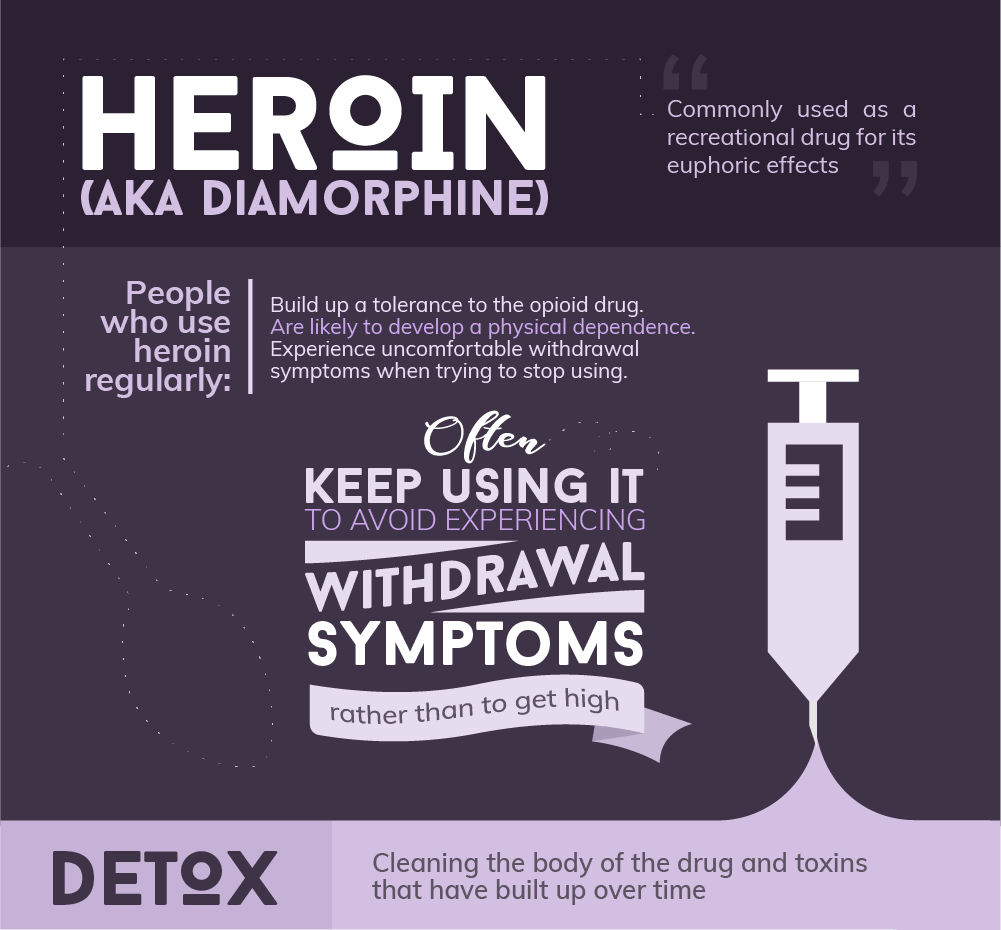
Heroin is a highly addictive drug. It’s made from morphine, which is a substance found in the seeds of some poppy flowers. It’s usually sold as a white or light brown powder. Heroin takes different forms amongst different regions and users, even within the U.S.
East of the Mississippi River, most heroin use is pure heroin. This is a bitter-tasting white powder. Most of it is manufactured in South America and Southeast Asia. It can be snorted or smoked. Newer drug users may prefer pure heroin because there’s no need to inject it. Injection is usually more highly-stigmatized than other possible methods of using heroin.
Alternatively, west of the Mississippi River, black tar heroin dominates the market. This form of heroin is either hard like coal or sticky like roofing tar. It is usually produced in Mexico. It is darker in color because of the impurities that remain after processing. Users of black tar heroin usually dissolve it, dilute it, and then inject it into their body.
Heroin use can feel good. Many users believe that the good feelings outweigh the dangers. We know, however, that heroin isn’t the solution, and there are other ways to feel good.
Users report heroin as a drug that decreases anxiety or physical and emotional pain. It provides feelings of warmth and relaxation. It can often make users feel detached from their environment. It is a strong sedative and pain reliever.
We know that heroin is dangerous on its own. However, like many drugs, heroin can also be incredibly dangerous when taken at the same time as other drugs or alcohol. These dangerous interactions between heroin and other substances may include:
One of the greatest dangers of heroin use is the risk of an overdose. While there is often help available for those who overdose on heroin, others don’t get this help in time. Many people die each year by overdosing on heroin or other opioids. These other opioids include Fentanyl and OxyCodone.
There are a few different reasons someone could overdose on heroin. These include:
If someone has overdosed, they will likely be breathing dangerously slowly. They may have a very slow heart rate or lose consciousness. It’s possible that their lips or fingertips will have turned blue because of this lack of blood flow and oxygen. They may also begin to stumble or slur as though very drowsy. Gone untreated for too long, these symptoms could develop further. Eventually, the user could have permanent brain damage, fall into a coma, or die.
There is, however, hope for those who overdose.
There is a drug called Naloxone that can aid in reversing a heroin overdose. Naloxone comes as both a nasal spray and an injectable shot. You can get Naloxone at some pharmacies without a prescription. It’s a good thing to have on hand if you or someone you know regularly uses heroin.
If you think someone has overdosed, administer Naloxone immediately. Then, call 911. Naloxone can temporarily help someone who has overdosed on heroin, but it is not a final solution. You should call emergency personnel to attend to the user as soon as possible. The results of naloxone won’t last forever.
Naloxone can be so important and life-saving. Even the U.S. surgeon general issued this statement about the drug as an official advisory:
“I, Surgeon General of the United States Public Health Service, VADM Jerome Adams, am emphasizing the importance of the overdose-reversing drug naloxone. For patients currently taking high doses of opioids as prescribed for pain, individuals misusing prescription opioids, individuals using illicit opioids such as heroin or fentanyl, health care practitioners, family and friends of people who have an opioid use disorder, and community members who come into contact with people at risk for opioid overdose, knowing how to use naloxone and keeping it within reach can save a life.”
Before looking at the treatment for heroin addiction, it’s important to know whether you are truly a heroin addict or simply a heroin abuser. There is a difference, and heroin detox or withdrawal isn’t even necessary if you’re only abusing the drug.
As Brand insinuates, an addict has no control over their addiction. The lack of control should be the first sign that someone needs help.
Drug abuse is simply the act of abusing - or misusing - a drug. That includes any form of using a drug outside of legal or medical guidelines. In a very broad sense, drug abuse can include:
Because heroin is illegal, any heroin use is drug abuse. If you do heroin at all, you are abusing the drug and are a drug abuser.
Abuse becomes addiction when the user can no longer easily choose to stop taking a drug. Because heroin is so highly addictive, this can be after the very first use for some people.
“The feeling in my head was, 'I want to feel like this for the rest of my life.' It was the perfect drug for me.”
~ Todd, heroin user
As the quote shows, the feeling itself can make people want to use heroin forever. This is part of the psychological side of addiction. Some users simply enjoy using heroin so much that they couldn’t voluntarily stop.
The other side of addiction, physical dependence, is perhaps harder to note. If you are physically dependent on heroin, your body will start to show signs of withdrawal if you aren’t using. This is why detox is so important. We’ll return to this theme later in more detail.
Physical dependence means that your body has come to rely on the presence of heroin to function. When someone takes heroin or another opioid, the drug attaches to opioid receptors in the brain. This action is what blocks pain and causes feelings of pleasure. Unfortunately, this can cause the body to stop functioning normally. It could stop creating the substance that would normally make us feel pleasure. There’s no need, when the body is receiving a steady supply of heroin.
Over time, this can happen to such a degree that when there’s no heroin, there’s nothing in the body to replace it. This is one of the reasons that withdrawal can be so uncomfortable, harmful, or painful. The body has no way of relieving pain without heroin - at least temporarily.
Perhaps you’re wondering what signs to look for in someone you suspect of being a heroin addict. Well, there are plenty of signs of heroin addiction, and many more of heroin use. It’s important to notice someone using heroin even if they aren’t yet addicted. Iit will be much easier to stop using earlier on in the habit.
If someone has been using consistently over time, they may develop these long-term signs of heroin use:
Obviously, not everyone showing any of these signs of addiction is a heroin addict. However, many of these signs together could be an indication of a loved one’s addiction. Try this addiction quiz if you’re still unsure if your loved one may be an addict.
One of the most certain signs of a heroin addict is withdrawal. This happens when the user begins to go through withdrawal if they don’t have the drug. A person who has used heroin at all may experience withdrawal symptoms when they try to stop using. For some people, even using the drug once will result in a withdrawal if they don’t use again.
Heroin detox is the process of ridding one’s body of the presence of heroin. Because of that, detox requires going through heroin withdrawal. As soon as your body realizes that the drug is gone, it begins to respond physically. These are the withdrawal symptoms.
"Withdrawal is the onset of a predictable constellation of signs and symptoms following the abrupt discontinuation of, or rapid decrease in, dosage of a psychoactive substance. Such signs and symptoms are generally the opposite of the intoxication effects of the particular substance."
~ The American Society of Addiction Medicine
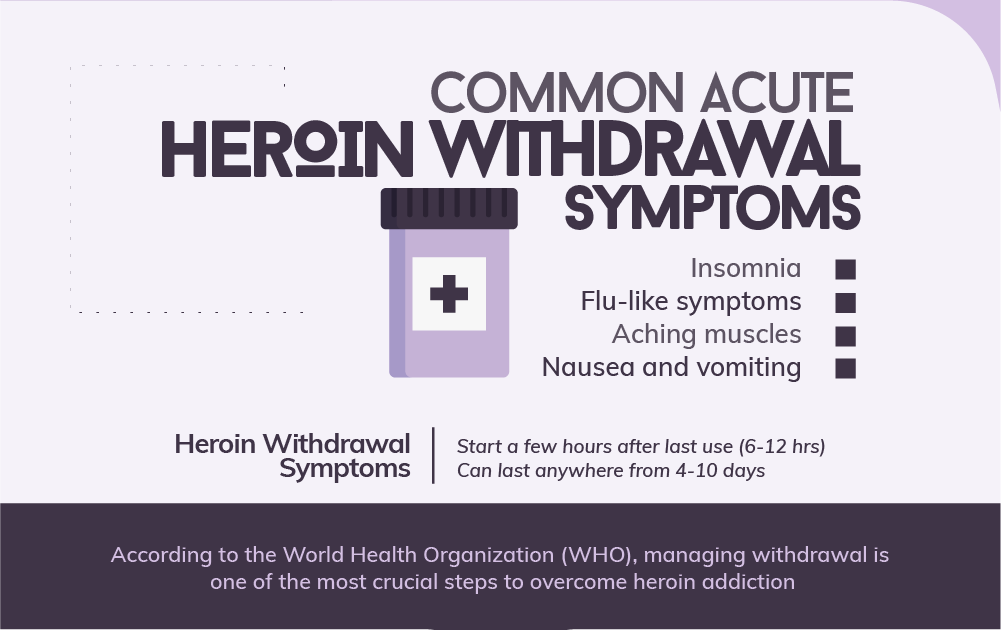
These symptoms may not occur in everyone who goes through heroin detox. However, everyone who goes through heroin detox will experience at least some of these withdrawal symptoms.
According to the World Health Organization, managing withdrawal is one of the most crucial steps of overcoming heroin addiction. This is because as opioid dependence takes hold on the person using heroin, the drug will be used increasingly to avoid experiencing withdrawal symptoms rather than as a means to get high. This is true of nearly all opioid drugs, but is particularly true of heroin use since the drug is so fast acting.
Check out this video to see a real life example of heroin withdrawal. The young woman in the video is not undergoing detox. Rather, she is going through the beginning stages of withdrawal because she hasn’t used the drug in some time.
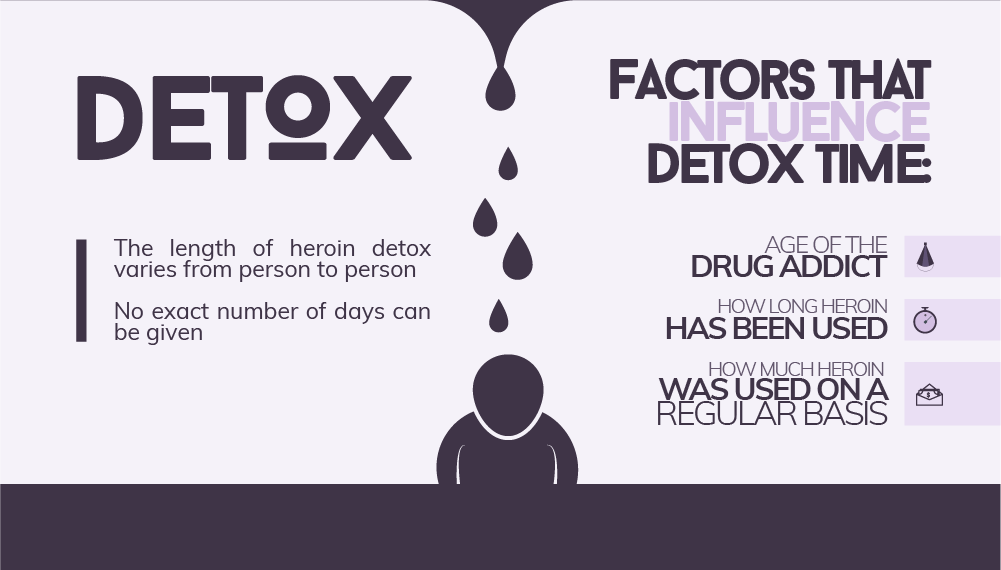
While knowing what heroin detox and withdrawal symptoms look like is definitely important, most people undergoing detox or withdrawal have one specific question: how long does it take to detox from heroin?
Well, there’s no clear and specific answer to this question. It may not be the response you’re looking for, but heroin detox rarely follows the exact same timeline from person to person.
Instead, the length of heroin detox can vary greatly from person to person, depending on many different factors. Some of the factors that affect how long withdrawal symptoms last include:
In other words, there is no exact number of days that heroin detox and withdrawal will last. Because of this, answering how long heroin detox takes is not necessarily straightforward. Neither the duration nor the intensity of heroin detox can be predicted exactly. However, detox professionals can provide a timeline of the average detox and withdrawal process for those using heroin. It’s simply important to keep in mind that this timeline is only approximate, and will be different for different users.
The most basic timeline can be broken down into two separate steps:
More specifically, those suffering from heroin addiction will begin to experience withdrawal symptoms just a few hours after last taking the drug. At first, these symptoms are mild. Withdrawal symptoms for heroin detox peak in the second or third day - meaning it will take at least a couple of days for an individual in recovery to experience the full force of the negative effects of the drug leaving the body. This will likely be the most challenging part of recovery.
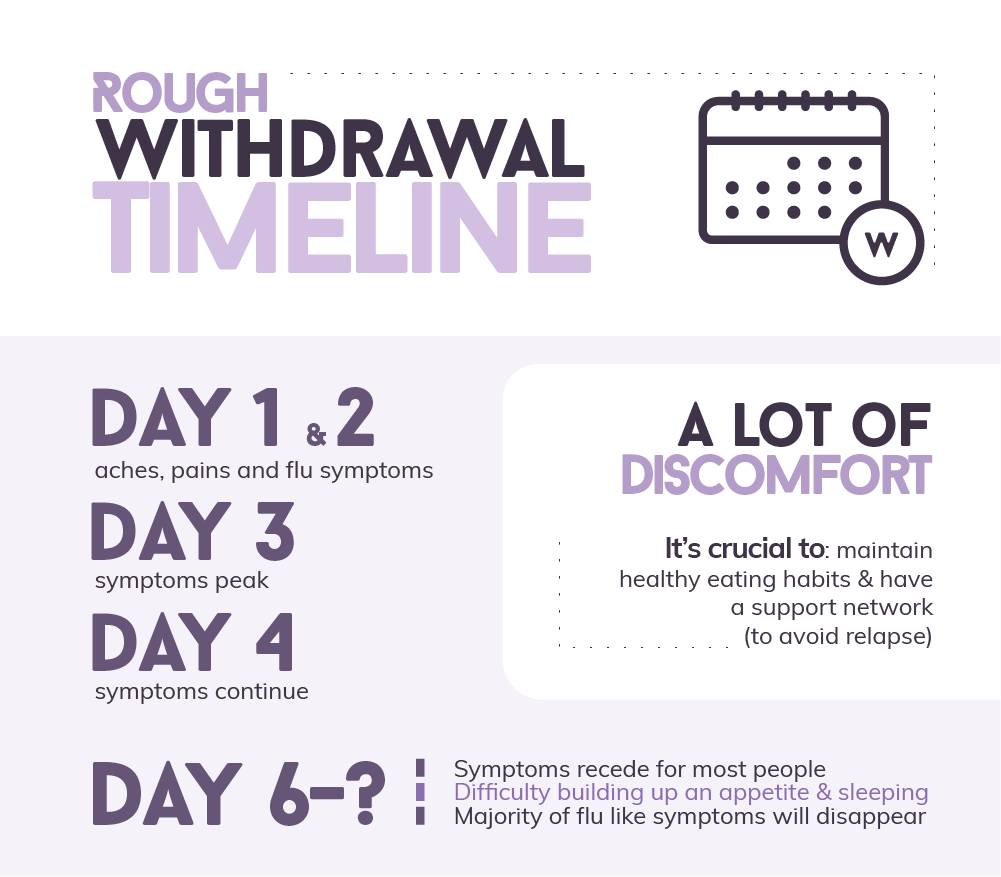
The more specifically a user’s addiction history is known, the more detailed the withdrawal timeline can be. Someone who has been dependent on heroin for just a short time may recover in a few days; in contrast, someone who has suffered from long-term addiction to heroin will take closer to two weeks to fully overcome the withdrawal symptoms. In general, heroin detox and withdrawal follows this loose timeline:
Heroin is known as a short-acting opioid. This means that the effects of the drug come on quickly, but the negative impact of the drug also tends to disappear more quickly. This is because heroin leaves the bloodstream quickly in comparison to other drugs. This means that withdrawal from heroin is, on average, much shorter than withdrawal from other drugs - even other opioids. This should be encouraging if you’re looking down the road to recovery from heroin addiction.
Here, we’d like to make note of the difference between heroin detox and the time frame in which one can expect to experience withdrawal symptoms. Most cases of addiction follow the patterns already described above. This is called acute withdrawal, though most people would simply call it withdrawal.
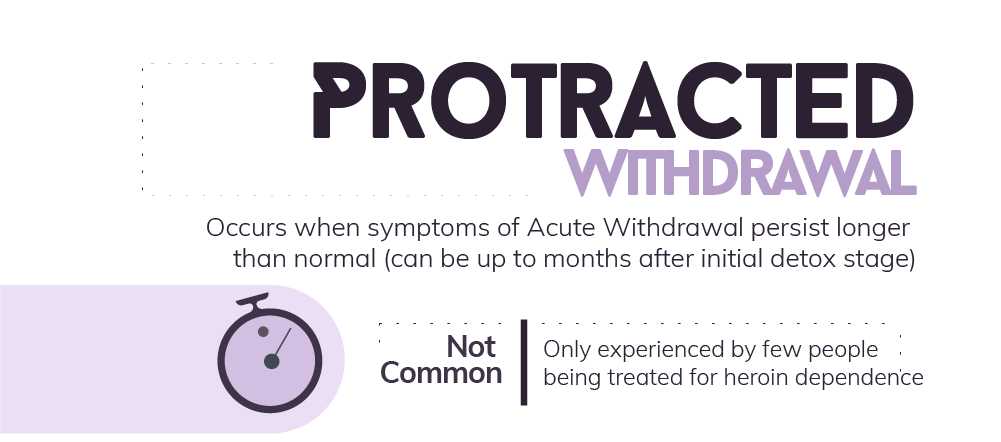
In contrast, some individuals experience protracted withdrawal. This simply means that an individual suffering from a substance use disorder continues to experience the signs and symptoms of withdrawal for longer than would be expected given the normal timeline. Protracted withdrawal tends to include all of the usual symptoms, but can include extra symptoms as well. These symptoms can sometimes seem completely unrelated to heroin withdrawal.
For example, the Substance Abuse and Mental Health Services Administration notes that some individuals in recovery for heroin addiction show issues in executive control functions (such as controlling impulses and problem solving). Only a minority of those in treatment for heroin dependence experiences protracted withdrawal. Still others will see some of the same withdrawal symptoms associated with heroin detox months after the initial detox stage. This does not happen often, but it is important to have the expectation that it is possible.
These types of withdrawal make clear the fact that recovery isn’t the same for any two addicts.
There is no question that heroin detox is a difficult and uncomfortable process. The symptoms of heroin withdrawal can feel like too much . So how can heroin detox and withdrawal be managed in a way that keeps recovery within reach? Is recovery from heroin addiction even worth it? Here, we provide some practical steps towards making the recovery process easier:
There is no magic solution when it comes to overcoming the symptoms of heroin withdrawal. However, following strategies outlined above can start you out on the right path. Engaging with these tips and finding professional help will ease the transition through one of the most difficult stages of the recovery process.
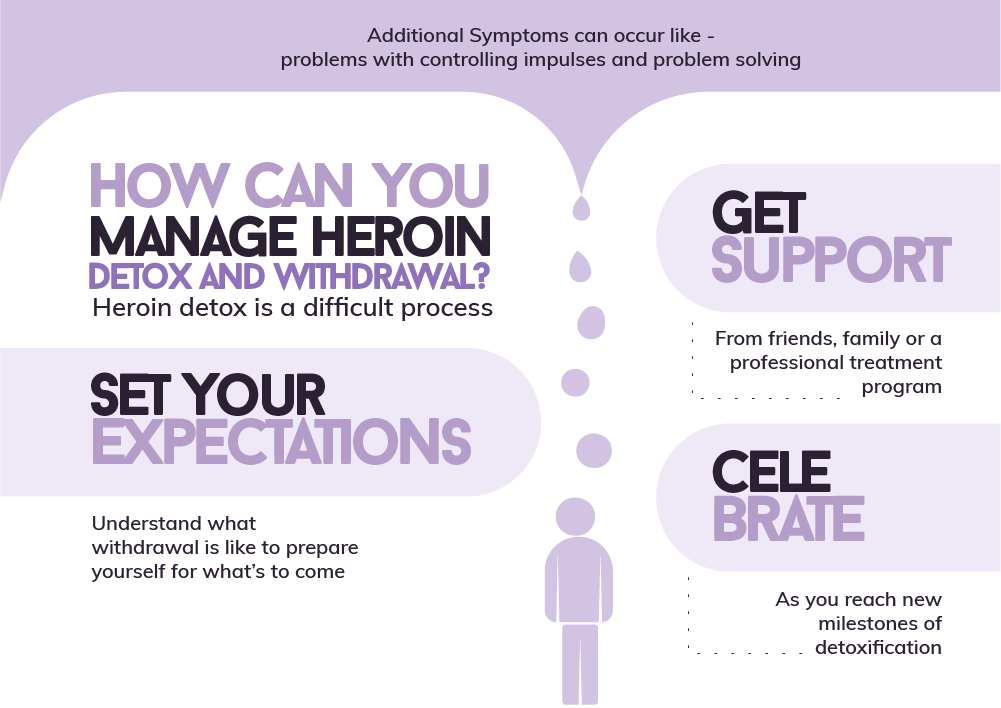
Doctors also choose to help ease withdrawal sometimes with medications. This process is known as medicated detox, and is available at many different detox treatment facilities. Medications are often used during the detox process for any of three purposes:
The symptoms of heroin withdrawal are both uncomfortable and dangerous. Many can cause true health risks, and others just make it increasingly likely that the user will relapse rather than experience the symptoms.
Many common medications are used for this purpose during heroin withdrawal. They can serve as a sedative, so that all physical symptoms seem decreased, or work directly against specific symptoms, such as stomach sickness or aching muscles.
It’s important that, if medications will be used during withdrawal, they are selected by a true medical professional. Otherwise, these drugs may cause an adverse reaction or mix poorly with the heroin still in the user’s system.
Other drugs used during recovery are those that can decrease cravings for heroin. These usually work by altering brain chemistry so that some other substance is replacing the heroine, and can slowly be taken away.
Sometimes, these drugs are even weaker opioids. These weaker opioids replace heroin in the brain and body and are then slowly tapered down. They are safer than heroin itself, despite having the same base ingredient and causing the same reactions in the brain.
Many times, addiction isn’t the only condition that requires treatment. If a user first began to use heroin to treat mental illness or other disorders, those same conditions may make the withdrawal process more difficult.
For example, many people experience extreme anxiety with going through heroin withdrawal. This may be increased if they already have anxiety. Tailoring this individual’s treatment specifically to keep anxiety in mind can help recovery go more smoothly. This is why it’s important to tell your doctor or other medical professional if you know of any co-occurring disorders.
There are four medications specifically that are often used during treatment for heroin addiction. There is always a chance that a doctor will choose to use other drugs as well, but these four are the most commonly used in this process. They include:
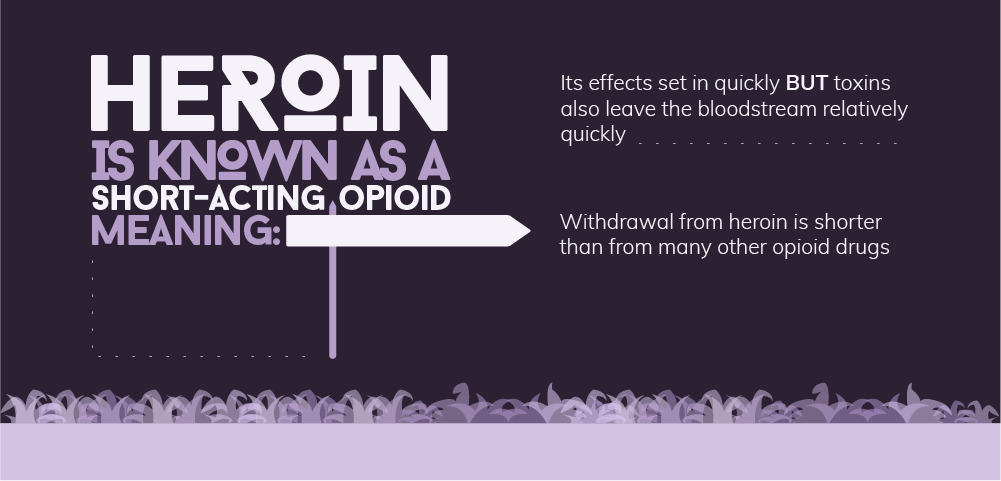
“I accidentally [got] involved in heroin after smoking crack for the first time. It finally tied my shoelaces together. Smoking dope and smoking coke, you are rendered defenseless. The only way out of that hopeless state is intervention.” - Robert Downey Jr.
Of course, it’s important to realize that detox is not the only step in overcoming heroin addiction or any other substance addiction. In fact, detoxification and enduring the withdrawal symptoms associated with this stage are only the first steps in a very long road to recovery.
Instead, every individual beginning the recovery process should be committed to recovering from the physical, psychological and social aspects of addiction. The full recovery process takes much longer than the week or two of heroin detox or withdrawal. After a heroin addict successfully detoxes from the drug, they should be sure to make plans to take part in both rehab and continuing follow-up care.
And, as Robert Downey Jr. says of his own addiction to heroin, users are often completely defenseless. This makes it all the more important that recovering heroin addicts find a support system or professional help. Someone needs to have control when they don’t. The best way to take control of your situation may be to give control to someone else until you’re strong enough to take it back.
While detoxing from heroin is an important step in the recovery process, it’s important to know that it only addresses the physical part of addiction. The psychological and social aspects of addiction must also be treated. This is where rehab comes in.
There are three main types of rehab programs: inpatient, outpatient, and intensive outpatient.
Inpatient rehab is what most people think of when they think of rehab at all. In this form of rehab, the recovering addict stays within the treatment facility for some time. They eat, sleep, receive treatment, and do everything else all within the facility.
Inpatient treatment is usually cited as the most effective form of treatment. This means that of all individuals who undergo treatment for addiction, those who have completed an inpatient program are the least likely to relapse in the future.
Outpatient rehab is a treatment style where the patient continues to live at home. During this time, they attend in-person therapy and treatment regularly. Despite the statistics regarding inpatient treatment, many also find success in outpatient treatment programs.
Intensive outpatient programs, or IOPs, are simply intense outpatient-style treatment programs. They require participants to be present much more often, and for much longer, than traditional outpatient programs. Many recovering addicts also have great success in this type of treatment program.
Despite the fact that many people looking at rehab options have an immediate preference between the types, it’s important to examine the pros and cons of each rehab style to determine what’s truly best for you and your recovery. In the lists below, we’ll consider intensive outpatient rehab simply as an extension of traditional outpatient rehab.
Inpatient addiction treatment can be beneficial because of the:
Inpatient treatment can be less than ideal sometimes, due to:
Outpatient treatment, however, can be beneficial due to:
Outpatient treatment can also be detrimental for some due to:
It’s possible that after completing detox and rehab, you’ll be good to go and not at risk for a relapse. However, this is unlikely. For most, addiction is a lifelong disease that must be constantly managed.
The good news is that there are many systems in place to help. They're for those who want to be extra sure that they won’t fall prey to a relapse.
One of the most common of these choices is a support group. Groups like Narcotics Anonymous meet regularly (usually weekly). They focus on recovery as a shared experience. Participants make their way through the 12 steps to recovery and learn to live a drug free life. All the while, they’re recovering alongside others who know what they're going through.
For those who want even more accountability and supervision, there are halfway houses. Transitional homes like these facilitate groups of recovering addicts to live all together. Each house is governed by a set of rules, usually including a curfew and a ban on all drugs and alcohol. Residents in such homes often attend group therapy together. They can also hold each other accountable to follow the rules of the house and to stay clean.

Have you been picturing yourself or someone you love as you’ve read this page? You may have realized that there’s a problem. Heroin addiction has stolen too many lives too early - don’t let yourself or someone you know be taken too.
If you still aren’t sure whether someone is truly a heroin addict, consider taking this addiction quiz about yourself or someone you know. If you determine that there is indeed a problem., the first step is to decide to seek help.
At Northpoint Seattle, our mission is to provide a safe, helpful and supportive recovery environment that helps build the foundation for a successful future. We operate with the utmost respect for every individual that passes through our doors. Our commitment to excellence means doing good for others and engaging in innovative, empirically-based treatment. In short, our mission is to help people get their lives back and show them respect and empathy in the process.
Northpoint Seattle is an intensive outpatient program designed with recovery in mind. If you aren’t sure if this treatment option is for you, call for a free addiction assessment now.
If you want to recover from heroin addiction, you’re in luck, because we want to help. Contact us today to start your road to recovery and regain your life from the jaws of heroin addiction.

Our admissions coordinators are here to help you get started with treatment the right way. They'll verify your health insurance, help set up travel arrangements, and make sure your transition into treatment is smooth and hassle-free.
[DirectNumber] Contact Us